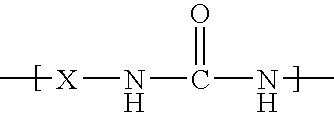Microcapsules having activated release of core material therein
a microcapsule and core material technology, applied in the direction of biocide, animal husbandry, plant growth regulators, etc., can solve the problems of not being able to crystallize normally therein, biological actives that are difficult to contain within microcapsules, and often possess significant water solubility or high volatility, so as to and increase the rate of release of biological active compounds
- Summary
- Abstract
- Description
- Claims
- Application Information
AI Technical Summary
Benefits of technology
Problems solved by technology
Method used
Image
Examples
examples
[0149] The following Examples are provided to illustrate one or more aspects of the present invention. They are therefore not to be viewed in a limiting sense.
Examples 1-3
Example 1
[316]
External Phase Preparation:
[0150] A 16-ounce jar was charged with 284.7 g of hot water (60° C.). While stirring, 5.8 g of 225A edible gelatin (commercially available from Milligan & Higgins, Johnstown, N.Y.) was added. The gelatin dissolves in 10-20 minutes. The jar was then sealed and placed in a 50° C. oven until needed (experience to-date suggesting that, for best results, the solution is preferably used within 8 hours.)
Internal Phase Preparation:
[0151] A 16-ounce jar was charged with 371.9 g of acetochlor that has been preheated to 50° C. Two isocyanates were then weighed into the jar: 10.6 g of Desmodur N3200 [the trifunctional biuret adduct of hexamethylene diisocyanate] and 14.2 g m-TMXDI [meta-tetramethylxylylene diisocyanate]. The solution was agitated to obtain a clear, homogeneous s...
examples 2 and 3
[349 and 344]
[0157] Examples 2 and 3 were prepared using substantially the same procedure as outlined above for Example 1, with the only variations being in the amounts of reagents used (including the two isocyanates), and manner in which the amine adduct was prepared. These differences are highlighted in greater detail below, as well as in the summary provided in Table A, below.
example 2
Amine Adduct / Blocked Amine Preparation
[0158] A 250 ml beaker was charged with 14.6 g (0.1 mole) TETA and 32.6 g water. With stirring, 18 g ( 0.1 mole) Dextrose was then added over a 45 minute period. The resulting solution was stirred for an additional 60 minutes, and then allowed to stand for 4 days in a sealed bottle.
[0159] The resulting product contained 3 equivalents of amine per mole adduct (or blocked amine), and was labeled TETA:Dextrose (1:1). Approximately 30.1 g was used in the remaining portion of the Example.
PUM
| Property | Measurement | Unit |
|---|---|---|
| temperatures | aaaaa | aaaaa |
| temperatures | aaaaa | aaaaa |
| temperatures | aaaaa | aaaaa |
Abstract
Description
Claims
Application Information
 Login to View More
Login to View More - R&D
- Intellectual Property
- Life Sciences
- Materials
- Tech Scout
- Unparalleled Data Quality
- Higher Quality Content
- 60% Fewer Hallucinations
Browse by: Latest US Patents, China's latest patents, Technical Efficacy Thesaurus, Application Domain, Technology Topic, Popular Technical Reports.
© 2025 PatSnap. All rights reserved.Legal|Privacy policy|Modern Slavery Act Transparency Statement|Sitemap|About US| Contact US: help@patsnap.com



